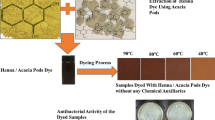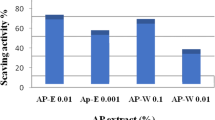Abstract
In the present study, an attempt has been made to investigate the possibility of protein fabric ecological dyeing with Carica papaya L. leaf dry powder extract as a natural dye. The effect of various metal salts (ferrous sulfate, alum and copper chloride) and natural tannin extracts (harda powder, pomegranate peel, orange peel and amla powder) as mordants on color and fastness properties of dyed protein fabric samples was comparatively observed. Dyeing experiments were performed with and without mordants, using all mordanting techniques, i.e., pre-mordanting, meta-mordanting and post-mordanting. The results of using bio-mordants for wool dyeing were comparable with that of the metallic mordants in terms of color strength and fastness characteristics. Bio-mordants produced quite different colors as expected from a mordant and thus offer full potential to replace metal salts in wool dyeing for ecological dyeing of textiles. UV spectra, FTIR, anti-microbial and UPF values were also evaluated. It was found that dye extract and dyed samples have very good anti-microbial behavior. The bacterial colony counting reduction (%) for both S. aureus and E. coli bacteria was found to be more than 90% for all the dyed fabrics. Dyed fabrics, especially wool, exhibited very large enhancement in UV protection. For wool, the UPF value increased from 79 for undyed wool to 704 after dyeing. In other fabrics, the UPF improvement was not very high owing to the low thickness and cover factor. Thus, dyeing with Carica papaya L. leaf dry powder extract can be a good alternative for medical textiles.


Similar content being viewed by others
References
M.M.M. Specos, J.J. Garcia, J. Tornesello, P. Marinoa, M.D. Vecchia, M.V.D. Tesoriero, L.G. Hermida, Microencapsulated citronella oil for mosquito repellent finishing of cotton textiles. Trans. R. Soc. Trop. Med. Hyg. 104, 653–658 (2010)
L. Huang, M. Gerber, J. Lu, A.E. Tonelli, Formation of a flame retardant cyclodextrin inclusion compound and its application as a flame retardant for poly (ethylene terephthalate). Polym. Degard. Stab. 71, 279–284 (2001)
W. Sricharussin, C. Sopajaree, T. Maneerung, N. Sangsuriya, Modification of cotton fabrics with β-cyclodextrin derivative for aroma finishing. J. Text. Inst. 100, 682–887 (2009)
S. Islam, M. Shahid, F. Mohammad, Perspectives of natural product based agents derived from industrial plants in textile applications—a review. J. Clean. Prod. 57, 2–18 (2013)
A. Guesmi, N. Ladhari, N.B. Hamadi, M. Msaddek, F. Sakli, First application of chlorophyll-a as biomordant: sonicator dyeing of wool with betanin dye. J. Clean. Prod. 39, 97–104 (2013)
A. Guesmi, N.B. Hamadi, N. Ladhari, F. Saidi, H. Maaref, F. Sakli, Spectral characterization of wool fabric dyed with indicaxanthin natural dye: study of the fluorescence property. Ind. Crops Prod. 46, 264–267 (2013)
G.W. Taylor, Natural dyes in textile applications. Rev. Prog. Color. 16, 53–61 (1986)
M. Yusuf, A. Ahmad, M. Shahid, M.I. Khan, S.A. Khan, N. Manzoor, F. Mohammad, Assessment of colorimetric, antibacterial and antifungal properties of woolen yarn dyed with the extract of leaves of henna (Lawsonia inermis). J. Clean. Prod. 27, 42–50 (2014)
H.T. Deo, B.K. Desai, Dyeing cotton and jute with tea as a natural dye. J. Soc. Dyers Color. 115, 224–227 (1999)
L. Ahlstrom, C.S. Eskilsson, E. Bjorklund, Determination of banned azo dyes in consumer goods. Trend Anal. Chem. 24, 49–56 (2005)
T. Bechtold, A. Turcanu, E. Ganglberger, S. Geissler, Natural dyes in modern textile dye houses—how to combine experiences of two centuries to meet the demands of the future? J. Clean. Prod. 11, 499–509 (2003)
S. Islam, L.J. Rather, M. Shahid, M.A. Khan, F. Mohammad, Study the effect of ammonia post-treatment on color characteristics of annatto-dyed textile substrate using reflectance spectroscopy. Ind. Crops Prod. 59, 337–342 (2014)
A. Manhita, V. Ferreira, H. Vargas, I. Ribeiro, A. Candeias, D. Teixeira, T. Ferreira, C.B. Dias, Enlightening the influence of mordant, dyeing technique and photodegradation on the colour hue of textiles dyed with madder—a chromatographic and spectrometric approach. Microchem. J. 98, 82–90 (2011)
D. Cristea, G. Vilarem, Improving light fastness of natural dyes on cotton yarn. Dyes Pigments 70, 238–245 (2006)
S. Islam, F. Mohammad, Natural colorants in the presence of anchors so-called mordants as promising coloring and antimicrobial agents for textile materials. ACS Sustain. Chem. Eng. 3, 2361–2375 (2015)
A.K. Samanta, P. Agarwal, Application of natural dyes on textiles. Indian J. Fibre Text. Res. 34, 384–399 (2009)
M. Shahid, S. Islam, F. Mohammad, Recent advancements in natural dye applications: a review. J. Clean. Prod. 53, 310–331 (2013)
S.N. Chattopadhyay, N.C. Pan, A.K. Roy, S. Saxena, A. Khan, Development of natural dyed jute fabric with improved colour yield and UV protection characteristics. J. Text. Inst. 104, 808–818 (2013)
G.H. Zheng, H.B. Fu, G.P. Liu, Application of rare earth as mordant for the dyeing of ramie fabrics with natural dye. Korean J. Chem. Eng. 28, 2148–2155 (2011)
M. Yusuf, M. Shahid, M.I. Khan, S.A. Khan, M.A. Khan, F. Mohammad, Dyeing studies with henna and madder: a research on effect of tin (II) chloride mordant. J. Saudi Chem. Soc. 19, 64–72 (2012)
S.M. Burkinshaw, N. Kumar, The mordant dyeing of wool using tannic acid and FeSO4, Part 1: initial findings. Dyes Pigments 80, 53–60 (2009)
P.S. Vankar, R. Shanker, D. Mahanta, S.C. Tiwari, Ecofriendly sonicator dyeing of cotton with Rubia cordifolia Linn. using biomordant. Dyes Pigments 76, 207–212 (2008)
H. Aminoddin, Functional dyeing of wool with natural dye extracted from Berberis vulgaris wood and Rumex hymenosepolus root as biomordant. Iran. J. Chem. Chem. Eng. 29, 55–60 (2010)
D. Villano, M.S. Fernandez-Pachon, M.L. Moya, A.M. Troncoso, M.C.G. Parrilla, Radical scavenging ability of polyphenolic compounds towards DPPH free radical. Talanta 71, 230 (2007)
A.E. Hagerman, Y. Zhao, S. Johnson (1997), Methods for determination of condensed and hydrolyzable tannins, in Antinutrients and Phytochemicals in Food, pp. 209–222 (1997)
M.L. Sanz, I.M. Castro, M.M. Arribas, Identification of the origin of commercial enological tannins by the analysis of monosaccharides and polyalcohols. Food Chem. 111, 778–783 (2008)
S. Adeel, T. Gulzar, A. Muhammad, F. Rehman, S. Muhammad, H. Iram, N. Iqb, Appraisal of marigold flower based lutein as natural colorant for textile dyeing under the influence of gamma radiations. Radiat. Phys. Chem. 130, 35–39 (2017)
L. Yu, J. Perret, M. Harris, J. Wilson, S. Haley, Free radical scavenging properties of wheat extracts. J. Agric. Food Chem. 50, 1619–1624 (2002)
K.L. Hatch, Making a claim that a garment is UV protective. AATCC Rev. 3, 23 (2003)
G. Hustvedt, P.C. Crews, The ultraviolet protection factor of naturally-pigmented cotton. J. Cotton Sci. 9, 47–55 (2005)
M.M. Alam, M.T. Islam, A review on ultraviolet protection of textiles. Int. J. Eng. Technol. Sci. Res. 4, 404–412 (2017)
S. Lalas, J. Tsaknis, Extraction and identification of natural antioxidant from the seeds of the Moringa oleifera tree variety of Malawi. J. Am. Oil Chem. Soc. 79, 677–683 (2002)
S. Pulipati, P.S. Babu, U. Naveena, S.K.R. Parveen, S.K.S. Nausheen, M.T.N. Sai, Determination of total phenolic, tannin, flavonoid contents and evaluation of antioxidant property of Amaranthus tricolor (L). Int. J. Pharm. Phytochem. Res. 9, 814–819 (2017)
V.N. Thakare, A.A. Suralkar, A.D. Deshpande, S.R. Naik, Stem bark extraction of Ficus bengalensis Linn for anti-inflammatory and analgesic activity in animal models. Ind. J. Exper. Biol. 48, 39–45 (2010)
C.A. Rice-Evans, N.J. Miller, G. Paganga, Structure-antioxidant activity relationships of flavonoids and phenolic acids. Free Radic. Biol. Med. 20, 933–956 (1996)
Y. Zou, Y. Lu, D. Wei, Antioxidant activity of a flavonoid-rich extract of Hypericum perforatum L. in vitro. J. Agric. Food Chem. 52, 5032–5039 (2004)
Sumaiyah, Masfria, A. Dalimunthe, Determination of total phenolic content, total flavonoid content, and antimutagenic activity of ethanol extract nanoparticles of Rhaphidophora pinnata (L.F) schott leaves. Rasayan J. Chem. 11(2), 505–510 (2018)
M.P. Kähkönen, A.I. Hopia, J.H. Vuorela, J.P. Rauha, K. Pihlaja, T.S. Kujala, M. Heinonen, Antioxidant activity of plant extracts containing phenolic compounds. J. Agric. Food Chem. 47, 3954–3962 (1999)
V.L. Singleton, R. Orthofer, R.M. Lamuela-Raventós, Analysis of total phenols and other oxidation substrates and antioxidants by means of Folin–Ciocalteau reagent. Methods Enzymol. 22, 152–178 (1999)
P. Shetgiri, P. D’Mello, Antioxidant activity of flavonoids—a comparative study. Indian Drugs 40, 567–569 (2003)
K.H. Prabhu, M.D. Teli, N.G. Waghmare, Natural dye extraction from waste barks of Turkish red pine (Pinus brutia Ten.) timber and eco-friendly natural dyeing of various textile fibers. Fibers Polym. 12, 753 (2011)
A. Waterhouse, Wine phenolics. Ann. N. Y. Acad. Sci. 957, 21–36 (2002)
J.S. Ledakowicz, J. Olczyk, J. Polak, M. Grąz, A.J. Wilkołazka, Dyeing of Textile Fabrics with Bio-dyes. Fibers Text. East. Eur. 23, 120–126 (2015)
A. Kechi, R.B. Chavan, R. Moecke, Dye yield, color strength and dyeing properties of natural dyes extracted from ethiopian dye plants. Text. Light Ind. Sci. Technol. 2, 137–145 (2013)
M.F. Hasan, Study on the changes of GSM (Gm/m2) of grey knitted fabric from pretreatment to finishing. Int. J. Text. Sci. 4, 119–136 (2015)
A.A. Nabawia, M.T.H. Moselhey, O.W. Guirguis, Study the effect of different dyeing conditions of extracted natural dye from leaves of neem on silk fabrics. J. Chem. Metrol. 12, 34–58 (2018)
J. Lee, M.H. Kang, K.B. Lee, Y. Lee, Characterization of natural dyes and traditional korean silk fabric by surface analytical techniques. Materials 6, 2007–2025 (2013)
S.M. Dhivya, K. Kalaichelvi, UV–Vis spectroscopic and FTIR analysis of Sarcostemma brevistigma, wight. andarn. Int. J. Curr. Pharm. Res. 9(3), 44–49 (2017)
C. Septhum, V. Rattanaphani, S. Rattanaphani, UV–vis spectroscopic study of natural dyes with alum as a mordant. Suranaree J. Sci. Technol. 14, 91–97 (2006)
H.P. Gies, C.R. Roy, G. Elliot, Z. Wang, Ultraviolet radiation protection factors for clothing. Health Phys. 67, 131 (1994)
Acknowledgements
The authors are grateful to the Department of Fashion Technology, BPSMV, Khanpur Kalan and Indian Institute of Technology, Delhi, for providing technical assistance for the study.
Author information
Authors and Affiliations
Contributions
The design of the study, experiments, interpretation of the data, writing of the paper, and all correspondences and revisions were performed by Neetu Rani. The experiments were performed by Neetu Rani under the guidance and supervision of Dr. Lalit Jajpura and Dr. B.S. Butola.
Corresponding author
Additional information
Publisher's Note
Springer Nature remains neutral with regard to jurisdictional claims in published maps and institutional affiliations.
Electronic supplementary material
Below is the link to the electronic supplementary material.
Rights and permissions
About this article
Cite this article
Rani, N., Jajpura, L. & Butola, B.S. Ecological Dyeing of Protein Fabrics with Carica papaya L. Leaf Natural Extract in the Presence of Bio-mordants as an Alternative Copartner to Metal Mordants. J. Inst. Eng. India Ser. E 101, 19–31 (2020). https://doi.org/10.1007/s40034-020-00158-1
Received:
Accepted:
Published:
Issue Date:
DOI: https://doi.org/10.1007/s40034-020-00158-1




